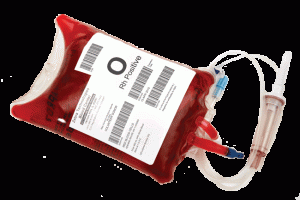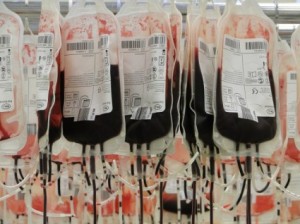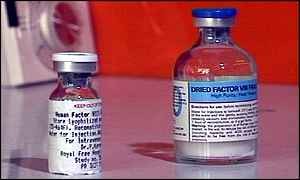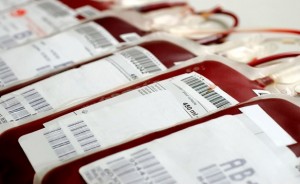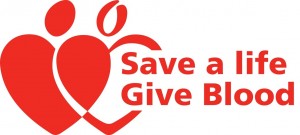Haemophilia – Blood & Blood Products
The Differences between Blood & Blood Products
When people think of a “blood transfusion” we generally think of the image above.
One whole bag of blood or a unit is most commonly used for patients who require an immediate “blood transfusion” for circumstances which could be seen as life threatening.
The most frequently used example of this use would be for road traffic accidents, violent attacks (stabbings) or patients needing intensive surgery where considerable blood loss could be a major factor. There are other various circumstances which call for a blood transfusion.
This blood is mostly sourced here within the United Kingdom. Donations are made on a voluntary basis and are put through a number of safeguards to eliminate contaminations. However this is still not 100% safe. Although, some donations used in the past came from British prisons and borstals, this course of action stopped in 1984.
However, 20,000 bags of blood or more went into the mass production of blood products used to treat Haemophiliacs.
So you start with 1 bag of blood which gets poured into huge vats and put through a process called “Fractionation” the end product is this, Factor VIII.
The bottle below appears to be a 2000 unit dose.
Each unit of this treatment was known to be 100% infectious for multiple contaminants, including HCV, HIV, HBV, EBV, CMV, Parvovirus B19, Bacteria, Fungus’s and the list goes on and on.
During the late 1990’s knowledge of the latest threat to the blood supply, nvCJD, known as the human form of mad cow’s disease had emerged. Many Haemophiliacs were placed on the “At Risk” register for public health purposes and to date there is still no validated blood test for this brain Prion.
From the inception of “heat treated” Factor VIII blood products during the mid 1980’s, all eligible Haemophiliacs were finally moved from the use of blood products to synthetic clotting treatments by 2006.
The threat from further infections and contamination was ignored, yet researched and studied within the haemophilia community for more than twenty years, despite safer synthetic products being available.
Although some haemophiliacs remain on blood products today due to problems, such as reactions or inhibitors to these synthetic treatments currently being manufactured. The use of blood products is now seen as being safer than during the 1980’s but still carries risks and the threat of future contaminations.
Without the volunteers who kindly come forward to donate their blood each day many of us would not be alive today and we must say a huge thank you to them. Please continue to give the gift of life and please demand the government makes the blood supply as safe as possible using science and technology not just assumptions and trust.
A whole blood donation may be separated into several different components that are used to treat a variety of medical conditions or illnesses. Get a behind the scenes look at how blood components are prepared.

